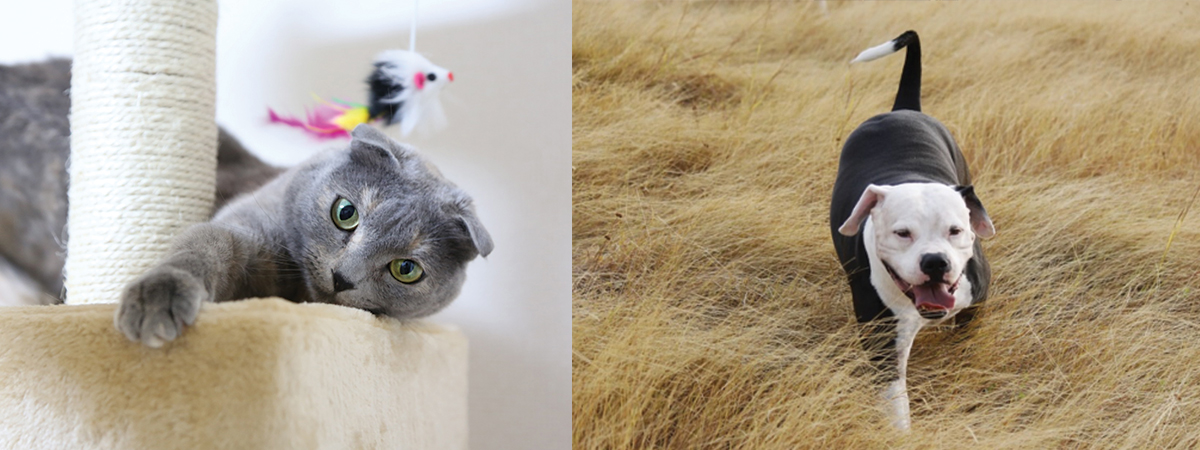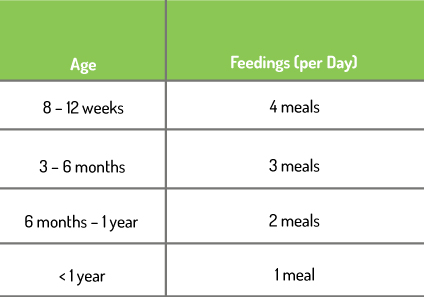
Promoting Healthy Lifestyles: How to Keep Your Pet Active and Lean
According to a clinical survey from the Association for Pet Obesity Prevention, in 2016 “53.9% of dogs and 58.9% of cats were classified as clinically overweight or obese by their veterinary healthcare professional.” In hard numbers, this means an estimated 41.9 million dogs and 50.5 million cats in the United States are too heavy for their body condition or frame.
While these statistics may feel staggering, the good news is that pet obesity is completely combatable! Just like for humans, incorporating a healthy approach to help your pet sensibly lose weight is achievable with a few simple lifestyle changes.
You can work with your veterinarian to develop a custom nutrition plan and fitness regimen that meets your pet’s specific wellness needs – and in the meantime, check out our general recommendations and tips for how to make routine exercise and a stable diet part of your lifestyle to keep your four-legged best friend healthy for years to come.
Fitness for Dogs
Exercise is a great way to help your dog stay physically fit and mentally stimulated. According to the American Society for the Prevention of Cruelty to Animals, exercise will not only help your pet burn calories and lose weight, but can also provide the entertainment your pup needs to avoid boredom in the hours you are away from home.
For dogs that may need to shed a few pounds, it will be important to focus on exercises that generate the accelerated heartbeat needed for sustained aerobic activity. Following the advice of veterinarian Dr. Ernie Ward from the Pet Obesity Prevention organization, it’s best to begin your pet’s daily exercise regimens with the more strenuous activities.
 Photo Credit: TC-TORRES via Pixabay
Photo Credit: TC-TORRES via Pixabay
Walking the Walk
Keeping the leash within two to three feet of your body, start out your walk at a “brisk” pace that is manageable for you and your pet to maintain – Dr. Ward recommends a pace of 15 minutes per mile. Avoid allowing your dog to regularly stop (aka: disrupt the pace) by tightening, not jerking, the leash and using quick commands such as “come” or “here.” The goal of these walks is to create continuity in your pet’s elevated heart rate and set the tone that this activity is not a casual stroll.
Dr. Ward recommends beginning with 30-minute walks at least five times a week to help most overweight or obese dogs who are otherwise of good general health drop some pounds. As your pet becomes accustomed to the daily exercise, you can slowly ramp up the walk’s intensity levels by following Dr. Ward’s sample fitness plan below:

The exact types and amounts of exercise that are right for your furry loved one will be different based on your dog’s age, breed, age and general health status, so always plan to consult with your veterinary professional to develop a fitness routine that is tailored for your pet’s specific needs. And remember — while exercise is an important part of maintaining your pet’s health, it’s also a great excuse to have fun and develop a deeper bond with your pup!
Nutrition for Dogs
Much like how fitness routines should be customized to your pup’s specific breed, age and health considerations, so too should their diet. Always plan to work with your fur baby’s medical team to determine the right nutrition plan to help your pup reach or maintain an optimal weight. Some general considerations from the ASPCA include:
For Puppies
- Use a high-quality dry food that is designed for your puppy’s specific breed or size growth and development
- Limit giving your dog “people food” in the early development months as too much can “result in vitamin and mineral imbalances, bone and teeth problems and may cause very picky eating habits and obesity.”
For Adult Dogs
- Search for a dry food that is of premium quality and can provide a balanced diet for your adult dog; Note: You can additional mix dry food with water, broth or canned food as necessary.
- Ensure that “people food” does not make up more than 10% of his or her daily caloric intake. Also be sure to check out our list of the foods to avoid feeding your fur babies as some common human food may have adverse side effects on your pet’s health

*Note: For some larger adult canines or those dogs prone to bloat, it may be better to feed them two smaller meals per day.
Ultimately, the amount that you feed your adult dog should be based on their size/breed and energy output. According to the ASPCA, animals with normal activity levels should receive what is called “maintenance” energy – essentially enough energy intake to equal what they burn off. Pets that are less or more active than “normal” may require adjusted portions to match their ideal maintenance amount.
Fitness For Cats
Contrary to popular belief, cats also need routine physical activity to keep their mental stimulation high and stave off the boredom that may lead to developing behavioral problems. A lack of exercise for your cat may also lead to other health concerns — According to research published in the Journal of American Veterinary Medical Association, obese cats are more likely than optimal weight cats to develop certain diseases throughout their lives, including (but not limited to) nonallergic skin conditions, diabetes, and lameness requiring veterinary care.
It Preys to Play
In addition to health risks that come with obesity, keeping your cat lean and active can be fun for you too. Natural hunters, cats enjoy playtime that allows them to mimic the activities of a hunt – stalking, jumping and pouncing at their “prey.”
The American Humane organization recommends creating challenges and games that can bring out your feline’s predatorial instincts by mimicking the movements of small animals (short, jerky motions) using an enticing toy (a fishing pole-type apparatus with features or streamers attached by a string or a laser to pointer) that they can chase and catch. Do this exercise for 10 minutes a few times throughout the day depending on your cat’s general health conditions and fitness level to make them strong and keep them healthy.
You may also consider purchasing a cat tree and placing the treats your cat loves most on the various levels of the carpeted tower to encourage him or her to jump and climb the structure for a good workout when you are not at home.

Photo Credit: notoneko via Pixabay
Nutrition for Cats
Another aspect of helping your furry feline loved one live a long any healthy life (aka: more time for the two of you to spend together sharing cuddles, snuggles, and belly rubs, of course) involves ensuring that your cat receives the proper amount and right types of nutrition.
Having evolved as hunters, cats require a diet with high quantities of protein, moderate quantities of fat, and minimal quantities of carbohydrates; as well as other vitamins and minerals. Because a cat’s nutritional needs may change throughout their lifespan, many of the commercial foods have been developed for the specific life stages of your cat.
For Kittens
- According to VetStreet, a meat-based, nutrient-dense canned wet food designed for kittens is an optimal diet for your fur baby beginning at four weeks of age. As always, consult your veterinary professional to determine the right commercial or specialty food for your kitten’s specific requirements.
- Avoid adding additional vitamin or mineral supplements to a nutrition-sufficient diet as this may cause unintentional harm to your kitten.
- Because of kittens’ small stomachs, it’s best to divide their food into three or four small meals a day; You can switch to twice-a-day feedings around six months.
For Adult Cats
- Plan to switch your kitten’s diet to the proper dry, wet or canned adult cat food for meal per day at around nine-to-12 months of age.
- Plan to gradually switch your cat’s food over from a kitten’s diet by mixing a little more of the adult food with the kitten food over several days. Note: Continuing to serve your cat kitten food for too long could cause him or her to gain too much weight too quickly.
- Be sure to follow up with your veterinarian during your cat’s annual check up to ensure you are providing your cat with a nutritional plan that is sufficient to his or her needs.
